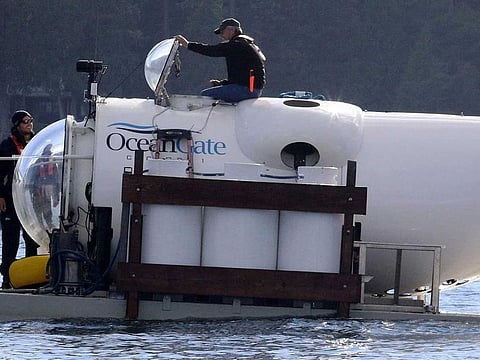OceanGate Titan missing: Titanic submersible has seven backup systems to return to the surface
One system is designed to work even if everyone aboard is unconscious

Rescuers were racing against the clock Wednesday to find a tourist submersible with five people on board that vanished on its descent to the century-old wreck of the Titanic.
In addition to an international array of ships and planes, an underwater robot had started searching in the vicinity of the Titanic and there was a push to get salvage equipment to the scene in case the sub is found.
CBS News journalist David Pogue, who travelled to the Titanic aboard the Titan last year, said the vehicle uses two communication systems: text messages that go back and forth to a surface ship and safety pings that are emitted every 15 minutes to indicate that the sub is still working.
Both of those systems stopped about an hour and 45 minutes after the Titan submerged.
“There are only two things that could mean. Either they lost all power or the ship developed a hull breach and it imploded instantly. Both of those are devastatingly hopeless,” Pogue told the Canadian CBC network on Tuesday.
The submersible had seven backup systems to return to the surface, including sandbags and lead pipes that drop off and an inflatable balloon. One system is designed to work even if everyone aboard is unconscious, Pogue said.
Aaron Newman, who has been a passenger on the Titan, told NBC’s “Today” show Wednesday that if the submersible is below a couple hundred meters and without power, the passengers are in complete darkness and it’s cold.
'Cold at the bottom'
“It was cold when we were at the bottom,” he said. “You had layered up. You had wool hats on and were doing everything to stay warm at the bottom.”
The submersible had a four-day oxygen supply when it put to sea around 6am Sunday, according to David Concannon, an adviser to OceanGate Expeditions, which oversaw the mission.
The US Coast Guard said remotely operated vehicle (ROV) searches were deployed in the area where Canadian aircraft detected undersea noises on Tuesday, as the clock ticked in the last 24 hours of the missing craft’s presumed air supply.
“Those ROV searches have yielded negative results but continue,” the US Coast Guard wrote on Twitter on Wednesday.
The 21-foot (6.4-meter) submersible Titan, operated by US-based OceanGate Expeditions, began its descent at 8am on Sunday, according to the US Coast Guard. It lost contact with its parent surface vessel soon after that during what should have been a two-hour dive to the Titanic.
The US Coast Guard said on Tuesday at about 1700 GMT that it had enough air for 41 hours, which would mean a deadline of roughly 1000 GMT on Thursday. The vessel has 96 hours of air supply, according to its specifications, assuming it is intact. But experts say the deadline depends on a range of factors, including whether it still has power.
The wreck of the British ocean liner, which sank when it hit an iceberg on its maiden voyage in 1912, lies on the seabed at a depth of about 12,500 feet (3,810 meters). It is about 1,450km east of Cape Cod, Massachusetts, and 640km south of St. John’s, Newfoundland.
Those aboard the submersible, the highlight of a tourist expedition that costs $250,000 per person, included British billionaire and adventurer Hamish Harding, 58, and Pakistani-born businessman Shahzada Dawood, 48, with his 19-year-old son Suleman, who are both British citizens.
French explorer Paul-Henri Nargeolet, 77, and Stockton Rush, founder and chief executive of OceanGate Expeditions, were also reported to be on board. The authorities have not confirmed the identity of any passenger.
Meanwhile, questions remain about how teams could reach the lost submersible, which could be as deep as about 12,500 feet (3,800 meters) below the surface near the watery tomb of the historic ocean liner. Newly uncovered allegations also suggest there had been significant warnings made about vessel safety during its development.
Meanwhile, documents show that OceanGate had been warned there might be catastrophic safety problems posed by the way the experimental vessel was developed.
David Lochridge, OceanGate’s director of marine operations, said in a 2018 lawsuit that the company’s testing and certification was insufficient and would “subject passengers to potential extreme danger in an experimental submersible.”
The company insisted that Lochridge was “not an engineer and was not hired or asked to perform engineering services on the Titan.” The firm also says the vessel under development was a prototype, not the now-missing Titan.
The Marine Technology Society, which describes itself as “a professional group of ocean engineers, technologists, policy-makers, and educators,” also expressed concern that year in a letter to Rush, OceanGate’s chief executive. The society said it was critical that the company submit its prototype to tests overseen by an expert third party before launching in order to safeguard passengers. The New York Times first reported about those documents.
Sign up for the Daily Briefing
Get the latest news and updates straight to your inbox



